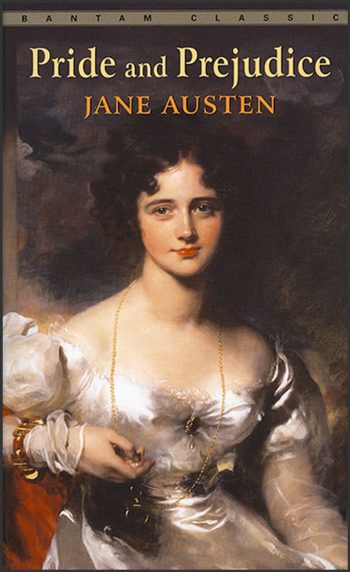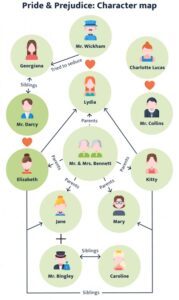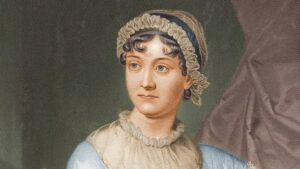
Pride and Prejudice
Summary
“Pride and Prejudice” by Jane Austen is a classic novel that follows the life of the Bennet family, particularly the second-oldest daughter, Elizabeth Bennet. The novel is set in early 19th-century England and explores the themes of marriage, social class, and gender roles.
The story begins with the arrival of Mr. Bingley, a wealthy and eligible bachelor, in the nearby town of Netherfield. Mrs. Bennet, the mother of the Bennet sisters, sees this as an opportunity to marry off one of her daughters to Mr. Bingley. At a ball, Mr. Bingley is introduced to Jane, the eldest Bennet sister, and the two quickly become attracted to each other.
At the same ball, Elizabeth meets Mr. Darcy, Mr. Bingley’s friend, and a wealthy landowner. However, their first encounter is not pleasant, as Mr. Darcy is seen as proud and aloof. Despite this, Mr. Darcy finds himself drawn to Elizabeth, but she remains skeptical of his character.
As the story progresses, Elizabeth and Mr. Darcy find themselves in a series of misunderstandings and confrontations, further fueled by the meddling of Elizabeth’s younger sister, Lydia. Eventually, Mr. Darcy confesses his love for Elizabeth and reveals the truth behind some of the misunderstandings.
As the story progresses, Elizabeth and Mr. Darcy find themselves in a series of misunderstandings and confrontations, further fueled by the meddling of Elizabeth’s younger sister, Lydia. Eventually, Mr. Darcy confesses his love for Elizabeth and reveals the truth behind some of the misunderstandings.
In the end, Jane and Mr. Bingley are reunited, and Elizabeth and Mr. Darcy overcome their pride and prejudices to confess their love for each other and get married. The novel ends with the theme of the importance of marrying for love rather than for social status or financial gain

- Themes
- Character Tree
- About the Author
- Pride and Prejudice – The title of the book itself suggests that one of the central themes is the idea of pride and prejudice. The novel explores the consequences of judging people based on first impressions, social class, and personal biases. The characters in the book are forced to confront their own prejudices and learn to overcome them.
- Marriage – Marriage is a significant theme in the book, and Austen portrays different types of marriages and relationships. The novel explores the social pressures and economic considerations that affect people’s decisions to marry. It also highlights the importance of mutual respect, compatibility, and love in a successful marriage.
- Social class – The novel also delves into the social class hierarchy of Georgian England, and how it affects people’s lives and relationships. Austen depicts the snobbery and prejudices of the upper class towards the middle and lower classes. She also shows the limitations and expectations placed on women of different social classes.
- Gender roles – “Pride and Prejudice” portrays the gender roles of the time, where women were expected to marry for financial security and social status rather than love. The novel challenges these gender roles by showing strong female characters who are independent thinkers and assert their own opinions.
- Love and relationships – Love and relationships are at the heart of the novel. The book shows how love can develop gradually over time, as well as the dangers of falling in love too quickly. It also explores the importance of honesty, trust, and communication in a relationship.
Here is a character tree for “Pride and Prejudice” by Jane Austen:
- The Bennet Family – Mr. Bennet Mrs. Bennet Jane Bennet Elizabeth Bennet Mary Bennet Catherine (Kitty) Bennet Lydia Bennet
- Friends and Acquaintances – Charlotte Lucas Mr. Collins
- Romantic Interests – Fitzwilliam Darcy Charles Bingley George Wickham

Each of these characters has their own unique personality, motivations, and relationships with the other characters in the novel, which creates a complex and intricate web of relationships and plot developments.
More information on the characters:
- Elizabeth Bennet – The protagonist of the novel and the second-oldest Bennet sister. Elizabeth is intelligent, witty, and independent-minded. She forms a close relationship with Mr. Darcy over the course of the novel and learns to overcome her prejudices.
- Fitzwilliam Darcy – The male lead in the novel, Mr. Darcy is initially seen as arrogant and proud by Elizabeth and others. However, he is revealed to be a loyal and generous man who is willing to change for the woman he loves.
- Jane Bennet – The eldest Bennet sister, Jane is kind-hearted and gentle. She forms a romantic relationship with Mr. Bingley but is hurt by his sudden departure from Netherfield.
- Charles Bingley – Mr. Bingley is a wealthy and amiable young man who falls in love with Jane Bennet. He is easily influenced by his friend Mr. Darcy but ultimately follows his heart.
- Bennet – The father of the Bennet sisters, Mr. Bennet is witty and cynical. He is exasperated by his wife’s preoccupation with marrying off their daughters but is also detached from their lives.
- Bennet – The mother of the Bennet sisters, Mrs. Bennet is obsessed with finding husbands for her daughters. She is loud, vulgar, and often embarrassing.
- Lydia Bennet – The youngest Bennet sister, Lydia is foolish and impulsive. She elopes with Mr. Wickham and causes a scandal for her family.
- George Wickham – A charming but deceitful man who has a history with Mr. Darcy. He elopes with Lydia and causes a scandal for the Bennet family.
- Charlotte Lucas – Elizabeth’s close friend and eventual sister-in-law, Charlotte is practical and pragmatic. She marries Mr. Collins for financial security.
- Collins – The pompous and obsequious cousin of the Bennet sisters, Mr. Collins is a clergyman who proposes to Elizabeth but ends up marrying Charlotte Lucas.
These characters and their relationships with each other drive the plot and themes of the novel.
Jane Austen

- Early life and ambitions: Jane Austen was born in 1775 in Steventon, Hampshire, England. She was the seventh child of a rector and grew up in a close-knit family that emphasized education and reading. Austen was a voracious reader from an early age and began writing her own stories and plays as a teenager. Her early works, including “Love and Friendship” and “Lady Susan,” were written in the epistolary form, which consisted of letters exchanged between characters.
As a young woman, Austen aspired to be a published author, and she worked on several novels throughout her twenties. However, it was not until the publication of “Sense and Sensibility” in 1811 that she achieved significant literary success.
- Literary Writing Style: Jane Austen’s writing style is known for its wit, irony, and social commentary. Her novels are characterized by their realistic portrayals of life among the English gentry, particularly the role of women in society. Austen’s works often explore the themes of love, marriage, class, and the limitations of social conventions.
Austen’s writing is marked by her skillful use of dialogue and her ability to create complex, fully-realized characters. Her characters are often flawed, but they are also sympathetic and relatable. Austen’s writing is also notable for its attention to detail and her ability to create vivid, immersive settings that bring her stories to life.
- Contemporary writers: Jane Austen was a contemporary of several other important writers of her time, including Sir Walter Scott, William Wordsworth, and Samuel Taylor Coleridge. However, Austen’s writing style and subject matter were distinct from those of her contemporaries. Unlike the Romantic poets of the era, Austen did not focus on the sublime or the supernatural. Instead, her novels focused on the everyday lives and concerns of ordinary people.
Austen’s contemporaries were not universally enamored with her writing. Some criticized her for being too focused on domestic concerns, while others found her writing to be too satirical. However, Austen’s works have endured over time and are now considered classics of English literature. Her influence can be seen in the work of countless writers who have followed in her footsteps, including the Bronte sisters, George Eliot, and Virginia Woolf.

